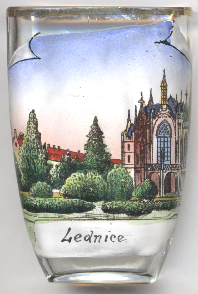

|
| ČESKÁ REPUBLIKA | CZECH REPUBLIC |
| Jihomoravský kraj | South Moravia (Brno) region |
| Okres: Břeclav |
Lednice is situated at an elevation of 173 m on the river Dyje in the Czech region of South Moravia, district Břeclav. The municipality has a population of about 2,300 (2014).
The village was founded in the 12th/13th century by German settlers, the first wirtten mention dates from 1222. Its name, spelled Izgruobi, Eysgruob, Aysgrueb and Eysgrueb developed into the modern German name Eisgrub. Already in 1286 the village obtained the right to hold weekly markets; however, it obtained the formal status of a market town only towards the end of the 16th century. From the mid-13th century, Eisgrub (in Czech: Lednice) was the main seat of the Liechtenstein family until their expropriation in 1945 (see Vaduz). After World War I, with the Treaty of Paris (Saint-Germain), the town became part of Czechoslovakia. With the agrarian reform of 1924 about two thirds of the princely domains were transfered to mostly Czech settlers. Occupied by German troops in 1938, Lednice became part of the Reichsgau Niederdonau until 1945 when it was returned to Czechoslovakia.


 Lednice castle
began its life as a Renaissance villa; in the 17th century it became a summer residence of the ruling Princes of Liechtenstein. The estate house — designed
and furbished by baroque architects Johann Bernhard Fischer von Erlach, Domenico Martinelli, and Anton Johan Ospel — proclaimed rural luxury on the grandest scale.
In 1846–1858 it was extensively rebuilt in a Neo-Gothic style under the supervision of Georg Wingelmüller. The surrounding park is laid out in an English garden style and
contains a range of Romantic follies by Joseph Hardtmuth, including the artificial ruins of a medieval castle on the bank of the Dyje River (1801) and a solitary sixty-metre minaret,
reputedly the tallest outside the Muslim world at the time of its construction (1797–1804).
In 1996 Lednice was inscribed on the UNESCO World Heritage List (together with the twin manor of Valtice) as "an exceptional example of the designed landscape that evolved
in the Enlightenment and afterwards under the care of a single family." (see also list of other UNESCO heritage sites)
Lednice castle
began its life as a Renaissance villa; in the 17th century it became a summer residence of the ruling Princes of Liechtenstein. The estate house — designed
and furbished by baroque architects Johann Bernhard Fischer von Erlach, Domenico Martinelli, and Anton Johan Ospel — proclaimed rural luxury on the grandest scale.
In 1846–1858 it was extensively rebuilt in a Neo-Gothic style under the supervision of Georg Wingelmüller. The surrounding park is laid out in an English garden style and
contains a range of Romantic follies by Joseph Hardtmuth, including the artificial ruins of a medieval castle on the bank of the Dyje River (1801) and a solitary sixty-metre minaret,
reputedly the tallest outside the Muslim world at the time of its construction (1797–1804).
In 1996 Lednice was inscribed on the UNESCO World Heritage List (together with the twin manor of Valtice) as "an exceptional example of the designed landscape that evolved
in the Enlightenment and afterwards under the care of a single family." (see also list of other UNESCO heritage sites)
[https://de.wikipedia.org/wiki/Lednice]
![[scale]](lineal.jpg)